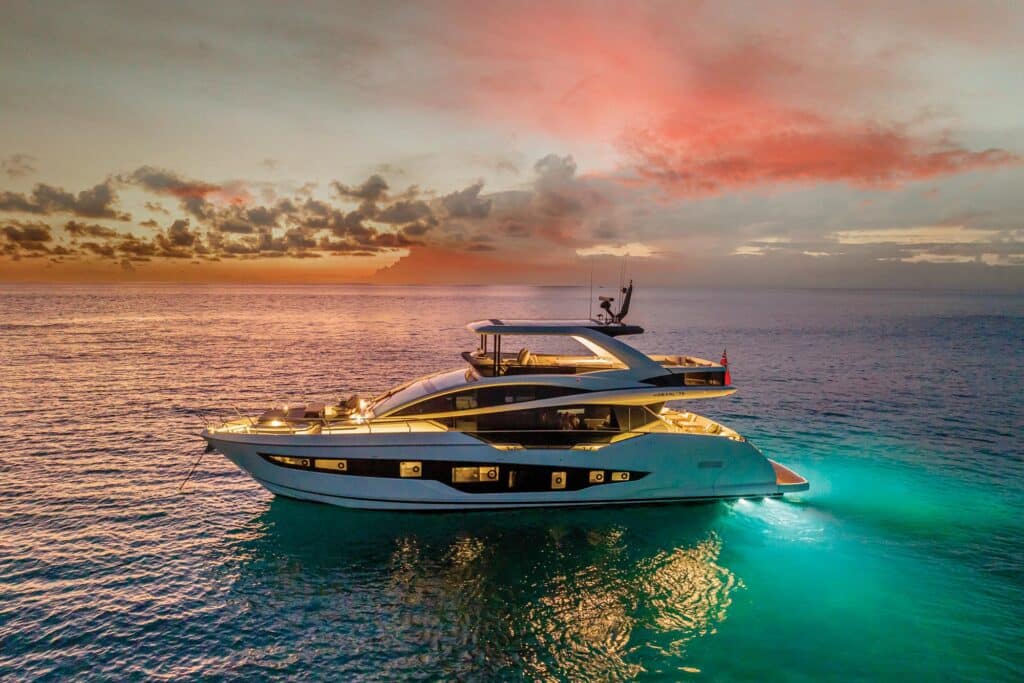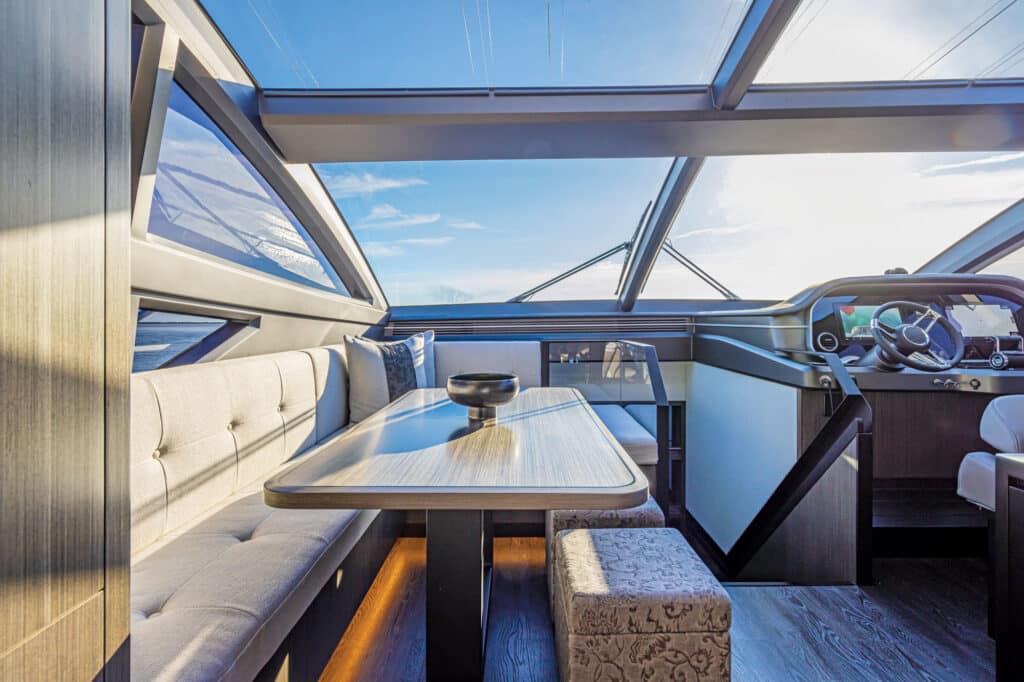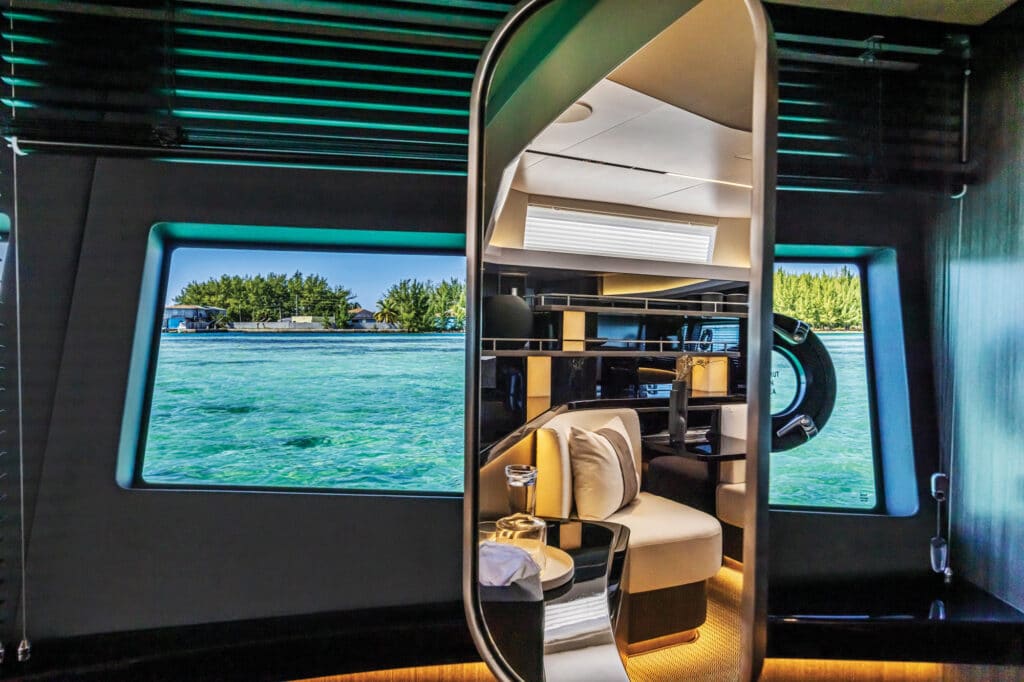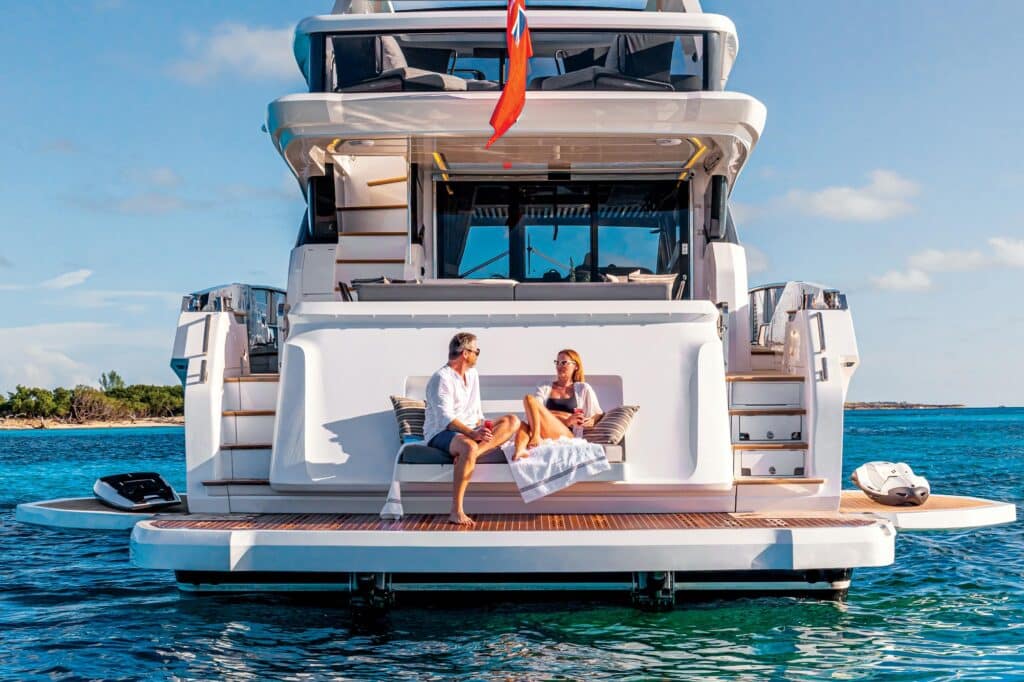
The Pearl 72 is an owner-operator yacht that radiates mega-yacht features. For starters, there are two master staterooms among the four en suite staterooms. The room that Pearl calls the “master” has a private entry typical of larger yachts, leading to a room with a forward-facing berth, high-gloss black cabinetry and windows for natural light. Triple closets, six under-berth drawers and the en suite head with shower make this space livable for long cruises.
The “guest master” is amidships with a separate stairwell from the salon, another mega-yacht feature. It also has a forward-facing berth and a private entry from a short hallway. A double-berth guest stateroom is to port. A twin-berth stateroom is to starboard, where the en suite doubles as a day head, accessible from the hallway. All staterooms have 6-foot-4-inch headroom.
Naval architect Bill Dixon penned the 72’s elegant exterior lines, which include long glass sections in the hull sides and a wider, 18-foot-10-inch beam. Interior designer Kelly Hoppen, CBE, created three interior schemes. The 72 I got aboard had the Indulgence theme, a solid rendition of a Monaco (or New York or London) penthouse in onyx marbles, dark bulkheads, a dark sole, and a look that doesn’t distract from the view. That view, by the way, is vast, with the coamings on the side decks cut down to allow windows just 17 inches above the salon sole behind the sofas. Forward, the skipper and guests have an almost unbroken windshield stretching from the deck to the flybridge, with a 4-foot shade to keep the sun at bay.
Other interior decor choices include pale-washed woods or traditional high-gloss dark wood. For me, the design theme called Indulgence complemented this yacht’s exterior lines.

The galley is in the salon, out of the way and abaft the helm seats, with a Miele four-burner induction cooktop, a convection oven, a grill, and a wine chiller. Opposite is a full-height home-size Dometic fridge. A second galley is in the crew space, which also has double bunks and a head with a stall shower.
At the helm, the skipper and companion reside on seats that draw on luxury cars with deep bolsters and individual adjusters. This 72 had the optional pantograph door next to the helm, making for easy access to the side deck. The skipper has a glass dash with twin Garmin displays; a row of tidy, well-marked rocker switches; and controls for the Side-Power bow and stern thrusters. Humphree custom Interceptor trim controls are automatic for ease of use at all speeds.
Up on the bridge, the full-length deck protects the lower cockpit and has a dining table with wraparound seating, a wet bar with a Kenyon grill, forward seating with a cocktail table, and a sun pad or a hot tub. All this equipage is shaded by a fiberglass hardtop with louvers that allow full sun, full shade or a breeze.
Yet another dining area is forward on the main deck: a high-low table with wraparound seating that becomes a sun pad when the alfresco meal is over. A Bedouin-style sunshade on poles cools the area when needed. On the remaining foredeck, and protected by double-welded rails, is the Lewmar V6 anchor windlass with foredeck and helm controls.

The cockpit is set up with a standard removable full enclosure for cool or wet climates. This space also has boarding doors on both sides and, on this 72, the optional Opacmare passerelle.
In keeping with luxury homes, there’s a multi-vehicle garage—the transom hinges up to reveal stowage that handles an 11-foot-3-inch Williams Sportjet 345 and a Sea-Doo Spark personal watercraft, with room for water sleds and dive tanks.
To make boarding easier from the water or dock, the aft coamings fold down, and a transom panel lowers to form beach-club lounge seating.
Underway, the Pearl 72 has light but positive electric steering that provides enough feedback for experienced skippers to “feel” the boat. During my time on the water, the conditions were stay-at-home sporty, but the Pearl 72 had no problem with a turbulent Gulf Stream and, in fact, seemed to relish the challenge. I didn’t even get a chance to test the windshield wipers.
Engine choices start at twin 1,400 hp MAN V-12s. This hull of the Pearl 72 upped the ante with twin 1,600 hp MTU 10V 2000 M96Ls using ZF gear boxes. I saw 33 knots in spite of an uncooperative and lumpy ocean, and the 72 offered up a comfy 22-knot cruise at 70 percent engine load. The factory, in better conditions, reported a cruise speed of 25 knots with a range of 250 nautical miles.
The engine room is reached via the crew quarters or from the tender garage. Considering the array of powerplants and systems, this space is surprisingly accessible by way of a centerline diamond-plate sole. The 72 I got aboard had an additional 20 kW Kohler genset and a Seakeeper 18 gyrostabilizer and the standard Applied Marine Automation AC/DC system.
The Pearl 72 is an able and seakindly cruising platform with a double-master layout. Add the ability to personalize the interior space, and this is a vessel that should appeal to owners looking to cruise with friends in comfort and style.

Williams Sportjet 345
The Pearl 72’s garage is sized to house a Williams Sportjet 345, which accommodates five people and has a top speed of 40 knots. The tender’s 90 hp Rotax engine draws on 13 gallons of fuel, and there’s an aft boarding platform for easy access from the water or dock. For kids or new drivers, a power-limiting switch keeps things safe.
Seakeeper 18
Designed to be lightweight (2,460 pounds) while still reducing up to 95 percent of a yacht’s roll, this Seakeeper doesn’t eat up much engine-room space (it’s 42 by 43 by 32 inches). The dashboard control provides the skipper with a reading on how the roll angle has been minimized. With all the critical components sealed in a vacuum, they are protected from the marine environment.
Take the next step: pearlyachts.com









